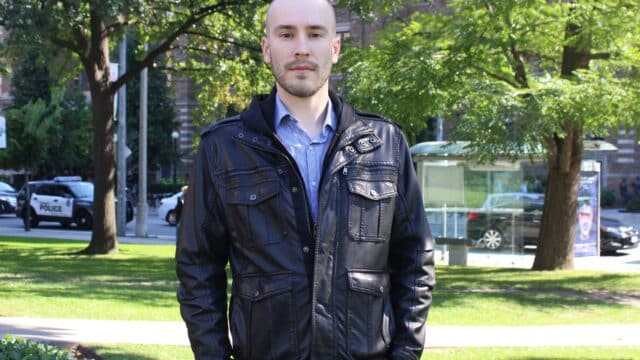Why we’re switching tactics in the fight to protect our clients from harmful pollution
Five years ago, we helped our clients Ada Lockridge and Ron Plain of Aamjiwnaang First Nation launch a lawsuit against the Ontario government and Suncor Energy. Up until this point, all other efforts to get the government and industry to address chronic air pollution in Chemical Valley had fallen on deaf ears.
But now, it looks like the government is finally taking action to fix some of the problems that led Ada and Ron to take legal action. That’s why, on our advice as their legal counsel, Ada and Ron have withdrawn the lawsuit. To achieve our shared goal of reducing harmful pollution in Ontario communities, we’re now focusing our energy on ensuring the government makes good on its new initiatives — starting with its efforts in Chemical Valley.
Admitting a problem is the first step to recovery
In Chemical Valley, located just outside of Sarnia, Ont., sirens can blare at any time of the day to warn people to stay indoors when all-too-frequent pollution incidents occur. Sometimes, incidents happen and residents only learn about them after the fact. Seldom do they hear about government follow-up and enforcement measures.
Despite the fact that the area is already home to 40 per cent of Canada’s chemical industry, the Ontario government has continued to approve more pollution with no consideration of the environmental or health effects it could have when combined with existing pollution in the area. To make matters even worse, some of these government decisions — including those at issue in the lawsuit — are made in secret, without community input. These kinds of decisions, the lawsuit argued, violated Ada and Ron’s constitutionally-protected Charter rights to security of person and equality.
But since that lawsuit was first filed, other influential voices have spoken out against what is happening in Chemical Valley. In response to requests for review we helped Ada and Ron submit, Ontario’s Environment Commissioner described pollution in Chemical Valley as “intolerable” and “truly shameful”, and strongly criticized Ontario’s approach to pollution approvals and failure to deal with their cumulative effects. In response, Ontario’s Minister of Environment and Climate Change acknowledged, for the first time, that the pollution crisis in Aamjiwnaang is unacceptable.
Addressing the cumulative effects of pollution
With Ecojustice’s support, Ada and Ron have long urged the Ontario government to deal with toxic hot spots like Chemical Valley. We’re cautiously optimistic to see that now, after much foot-dragging, the government is starting to take the kind of action we expected would flow from success in the courtroom.
In the Sarnia area, the government is making an effort to control pollution from major contaminants and has committed to a more stringent sulphur dioxide standard — a key contaminant at issue in the lawsuit. The government has also asked industry to provide them with flare-minimization plans. Jurisdictions in the United States already take this approach to address pollution from flaring — this practice of burning off toxic chemicals into the air is a major concern for the people of Aamjiwnaang.
The government has confirmed plans to divide Ontario into air quality zones and prioritize pollution reduction in Zone 3 — which includes the Sarnia and Hamilton due to their concentration of large industrial facilities that heavily pollute the surrounding air.
We plan to work with Ada and Ron to ensure that these new initiatives lead to an improved approach to regulation — one that takes existing air pollution into account when issuing new approvals — to better protect community health.
Improving communication with the people of Aamjiwnaang
Ontario has started to improve the way it communicates about pollution in Aamjiwnaang. This is also the sort of action we expected would result from a successful lawsuit.
Government staff have come to Aamjiwnaang to ask Chief and Council, the Environment Committee, and community members like Ada how they want to receive information about pollution events and the government’s response. They have recently started putting information about pollution incidents, and what government is doing about them, on Facebook. They also plan to make it easier for community members to look at air quality data by posting it online.
This is a crucial change in behaviour. The secrecy that characterized government decision-making about pollution left the people of Aamjiwnaang in the dark, exacerbating anxiety and stress about what was happening in their own community.
Ontario has also struck a Clean Air Sarnia and Area Community Advisory Panel that community members can join to share concerns about, and help address, local pollution problems. In other Ontario communities, such as Hamilton, these panels have contributed to better understanding of pollution issues and led to more effective community engagement with government regulators.
These actions are a good start. To be truly effective, industry representatives will also need to come to the table to address pollution concerns and share information. And because community solutions should involve the affected community, the people of Aamjiwnaang and surrounding communities also have an important role to play in using, and helping improve, these tools.
The fight for environmental justice continues — in Aamjiwnaang and across Canada
The cumulative air pollution crisis in Aamjiwnaang is an urgent human rights issue that requires immediate action. Cumulative pollution poses serious risks to the health and well-being of community members; this and a lack of opportunities for meaningful community engagement continue to cause stress and anxiety for residents.
Immediate, on-the-ground change is desperately needed in Chemical Valley and other pollution hot spots in Ontario. That’s why we are putting down one tool and picking up another — changing course, at least for now, from litigating to working with Ada, Ron, and the Aamjiwnaang community to ensure that Ontario’s new initiatives lead to durable community solutions.
Working with Ada and Ron has deepened our commitment to advancing the recognition and protection of the basic human right to a healthy environment — including clean air, safe drinking water, and a stable climate. When we first launched this case, few people in Canada had an understanding of what “environmental rights” were. Five years later, a groundswell of public support has led more than 130 municipalities, representing a third of Canada’s population, to pass declarations in support environmental rights.
This is remarkable progress. Recognizing the right to a healthy environment is the natural next step in the progression of human rights law in Canada, and we look forward to seeing Canada’s governments take action on this front in the coming months and years.
More than 110 countries around the world have already taken steps to enshrine their residents’ right to healthy environment in law. As our video below explains, we only need to look to Brazil to know that when governments decide to stand up for environmental rights incredible things can happen.
Now it’s Canada’s turn.





